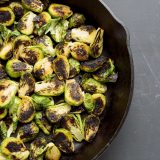Even if you’re willing to put in the time, the results can disappoint. Pile too many sprouts in the pan and they steam, turning mushy and dull. Let them go too long and they get dry and bitter.
We wanted better, more reliable results, and in much less time. To do that, we needed to understand what was happening in the oven. We discovered there is some chemistry at play.
Chopping, shredding or even chewing a sprout releases the enzyme myrosinase. That enzyme converts sulfur-containing compounds in the sprout into bitter-tasting compounds. The same reaction occurs across the brassica family, including mustard seeds, radishes and cabbage.
But heat neutralizes that enzyme-induced chemical reaction. Once the internal temperature of a sprout goes above 140°F, the myrosinase is inactivated. So we knew we needed high heat.
Our search for a better way got a boost during a sampling of grilled and wood-fired vegetables at Gjelina, chef Travis Lett’s Los Angeles restaurant. We loved the meatiness the dishes developed from Lett’s rough, almost steak-like treatment of produce.
In particular, the charred Brussels sprouts with chili-lime vinaigrette. They were both wonderfully charred and tender, and bore little of the brassica’s characteristic bitterness. We assumed—wrongly—that Lett had roasted them in a very hot oven
In fact, he had used a cast-iron skillet to accomplish in minutes what normally took us a half-hour or more. And he did it much better. This made sense. Cast iron holds heat extremely well, and the more it holds, the more it can transfer to the food. That process happens more quickly—and more intensely—than oven roasting, because air neither holds nor transfers heat efficiently.
We tried it and loved the way the searing-hot skillet gave the sprouts a delicious char we’d never achieved in the oven. Chemistry again was at play. In the oven, the sugars in the Brussels sprouts caramelize, which occurs between 320°F and 380°F. But the intense heat in the cast-iron skillet pushes the surface of the sprouts to 400°F or more, the temperature at which charring occurs. And with charring comes more intense flavors.
We next discovered that sprout size—as well as how they are prepped—matters greatly. Larger sprouts didn’t taste as good as small or medium ones. That’s because larger sprouts contain a higher concentration of the compounds that lead to bitterness. The heat of the pan wasn’t able to penetrate larger sprouts quickly enough to mitigate that process during our shorter cooking time. And even with smaller sprouts, we liked them best when cut in half, creating more surface area and contact with the skillet and therefore more charring.
Some chefs char their vegetables in a dry skillet, but we found this produced dry, tough Brussels sprouts. Adding oil to the pan helped a bit but didn’t add much in terms of flavor. The best technique was tossing the sprouts in oil, which helped them retain moisture and boosted their flavor. Just a tablespoon of extra-virgin olive oil gave us tastier, tenderer charred sprouts.
Next, we focused on seasonings. A cast-iron pan takes time to heat up, offering an opportunity to briefly heat a simple sauce. We already had olive oil on hand, so bagna càuda—the warm garlic- and anchovy-infused dip from Northern Italy—seemed like a natural fit. High heat would neutralize the fishy flavors of the anchovies, yet preserve their salty, savory side. Minced garlic would stand up to the anchovies. The combination, plus red pepper flakes and a final splash of lemon juice, resulted in a rich, tangy dressing.
But we also wanted a note of sweetness to soften the bitterness from the sprouts and from the charring. A drizzle of honey did the trick. It contributed a complexity that made us wonder if it might enhance the initial toss with olive oil, as well.
When we tested the recipe with that addition, the outcome surprised us. The finished sprouts had deeper color and flavor, and their texture was better, too. The color and flavor we knew were thanks to the glucose and fructose in the honey; they caramelize faster than sugar, which is mostly sucrose. But the sprouts also were moister. Why?
The answer was honey’s hygroscopic nature, or tendency to attract water molecules. Caramelized honey loses its water content, but the final drizzle of honey in the dressing at the end locks in moisture and makes the sprouts tenderer.
The final dish had the meaty flavor, nutty texture and bright notes of the best Brussels sprouts we’ve tasted, and we had accomplished it in minutes.




